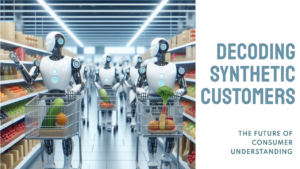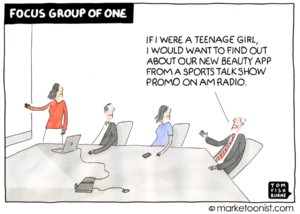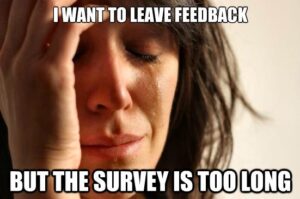The rise of synthetic data is likely to disrupt market research in a major way, enabling marketers to access insights more quickly and more cheaply.
**
Esref Armagan is a Turkish painter who has been blind from birth.
He paints remarkably vibrant pictures based on a world that has been described to him, rather than one which he has seen himself. His paintings would not look out of place in a gallery, and you wouldn’t guess that the person creating the image had never actually laid eyes on the scene he has painted.

Reading about Armagan reminded me of a quote I had seen earlier about synthetic data, from Jodie Shaw, Head of Global Marketing at Kadence international (a global market research firm):
“Imagine an artist who’s never seen an actual sunset but has read about its colours, its patterns, and the emotions it evokes. Using this information, they paint a sunset. While it’s not a reflection of an actual sunset they’ve witnessed, it captures the essence, the characteristics, and the general feel of one. This is the essence of synthetic data. It’s data that hasn’t been directly observed or collected from real-world events but has been algorithmically crafted to resemble and mimic real data in its structure, patterns, and behaviour”.
Market research – ripe for disruption
The most easily disrupted businesses are those where the value equation for clients is completely out of balance. Retail distribution, music streaming, rideshare services, there are endless examples of industries where the end consumer was copping it until a disrupter in shining armour came along.
According to many observers, market research could be another such industry, and while that’s unlikely to raise so much of a murmur from consumers, marketers – especially B2B marketers – could get very excited.
What is synthetic data?
Synthetic data has the appearance of data sourced from actual human responses, but in fact is artificial, crafted through algorithms and models to mimic the structure and patterns of actual data without the baggage of privacy concerns or accessibility challenges.

Why is this a big deal?
As an insight driven marketer, I have been a longstanding advocate of market research. Testing everything from product features to market demand, logo design, and messaging, speaking to actual customers helped my employers dodge many an expensive bullet.
Over the journey, the hundreds of thousands I have spent on market research has been an investment, saving millions in poorly conceived products and misdirected marketing spend.
And that overall approach still makes absolute sense.
But the reality is traditional market research has a few shortcomings – chief among them being that it can be ridiculously expensive to generate any reasonable quality and quantity of data.
Qualitative data – based on the opinions, experiences and behaviours of subjects is typically gathered through focus groups (you can gather it though surveys but that can be problematic). And focus groups – which need to be well moderated to ensure they don’t get dominated by one or two overeager participants – can be expensive.

Quantitative research – just the pure numbers – is generally all survey based (qualitative research can be survey-based too), but these days getting people to respond to surveys can be hard, especially surveys that ask any meaningful questions.
It’s why you see so many surveys for trade publications that are incentivised – “complete this survey for a chance to win megabucks!” – it’s only way you can get more than 100 responses. Advisors are constantly being asked for their views, by everyone from fund managers to tech providers to media outlets, and understandably, survey fatigue has become a real thing.

The most disruptible aspects of traditional market research are thus the time, the cost, and just the general difficulty in getting any meaningful sample size (a task that has become harder as privacy laws tighten up access to surveyable datasets).
Is synthetic data accurate?
Readers of this column will know I am a fan of Professor Mark Ritson, and in a recent article he recounts an example involving an EY survey of C-Suite decision makers. Basically, the same survey questions (qual and quant) EY had put to a group of (human) executives were put to a panel of synthetic customers. When the results were compared, there was a 95% correlation. As Tony Clayton-Hine, EY CMO for the Americas, told Adweek magazine:
“It was astounding that the matches were so similar. I mean it was 95% correlation”.
These results had been achieved in a fraction of the time and at a fraction of the cost.
The downsides with synthetic data
Basing decisions on data that hasn’t been validated in the real world can lead to all sorts of problems. Synthetic data extrapolates its original source data, which means any inherent inaccuracies, or biases, will be amplified. And by its nature, synthetic data may be too backward looking, missing the subtle nuances of shifting consumer preferences.
But these are hardly insurmountable.
Ultimately, it’s about the data
The age of synthetic data has arrived. But let’s not lose sight of what’s important here. Synthetic data is really just about a cheaper, faster way to get what you need to make good decisions – data and insights.
At Ensombl, we are lucky in that we have nearly 9,000 advice professionals using our platform to learn, collaborate and share. Whenever they read, like, share, or interact with a post, they are giving us insights into the problems they are trying to solve.
Our recently published What Advisors Want Report summarises these insights, distilling them down into the topics, issues, and brands that are dominating their thoughts. The Report is based on an analysis of over 2 million data points.
Our partners reap a dividend from these insights in the form of a 45% uplift in responsiveness.
Reach out and we can show you how. We promise you’ll be talking to a human!

